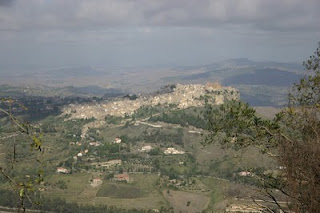Enna from the Castle

Neighbouring hill-top town as seen from Enna

Etna from Enna

Siracuse's Duomo

Greek temple columns built into the walls of the Duomo

After the wallet debacle in Rome we decided I should try a “man-purse” like all the well-dressed Italians were wearing. Reg picked it out and I wore it around for an afternoon when it was felt that despite my height and girth, I was having trouble carrying it off and that we would be more comfortable if Reg wore the purse and I wore her bandolero. Feeling slightly like Pancho Villa, I donned the device and we headed off to revisit Enna on a sunny day.
Once more we climbed the mountain to the Castel di Lombardia, a gloomy stone affair erected by the ruling Lombards in the 13th century. A climb up some narrow stone steps to the top of the tower yields stunning views of the surrounding countryside, including a neighbouring hill-top village and Mount Etna, snow-capped in the distance.
Foolishly, we let Mable goat-track us down a road which had obviously not seen cars for years (the locals pointed at us in awe) to the Autostrada and struck out for Catania on the coast. The old part of town is built from black, volcanic rock and is dim and gloomy as a result. The new town boasts roads that are often two lanes wide and not much else. After Mableing around helplessly trying to get to a reputedly famous garden, we pushed on to the new Autostrada to Siracuse. The first 20 km or so alarmed Mable exceedingly, since we were not on a road according to her. But she eventually settled down and we whisked into town and found our hotel near the harbour in no time.
First settled by the Corinthians in 733BC Siracuse reached full power over the Mediterranean, after an alliance with Agrigento allowed the Greeks to defeat the Carthaginians in 433BC. Siracuse then continued to grow in power and dominated the Med for 500 years. At one time it’s population was three times what it is today. Eventually, the Romans arrived, besieged the city and were so annoyed by the ingenious defenses thrown against them, that when the city finally fell they slew the mastermind behind them on sight. That was the famous Archimedes and to this day there is a square named after him in the old town on the island part of Siracuse, know as Ortygia.
Also on the island is the Duomo. I know, another church! This one is rather special though, in that it incorporates into its walls Greek columns from the pre-existing temple of Athena on that site, that date from 530 BC . To round out the Greek theme, down the street is the Fountain of Arethusa where the goddess supposedly surfaced after swimming across from the Pelopponese.
Whew!
Once more we climbed the mountain to the Castel di Lombardia, a gloomy stone affair erected by the ruling Lombards in the 13th century. A climb up some narrow stone steps to the top of the tower yields stunning views of the surrounding countryside, including a neighbouring hill-top village and Mount Etna, snow-capped in the distance.
Foolishly, we let Mable goat-track us down a road which had obviously not seen cars for years (the locals pointed at us in awe) to the Autostrada and struck out for Catania on the coast. The old part of town is built from black, volcanic rock and is dim and gloomy as a result. The new town boasts roads that are often two lanes wide and not much else. After Mableing around helplessly trying to get to a reputedly famous garden, we pushed on to the new Autostrada to Siracuse. The first 20 km or so alarmed Mable exceedingly, since we were not on a road according to her. But she eventually settled down and we whisked into town and found our hotel near the harbour in no time.
First settled by the Corinthians in 733BC Siracuse reached full power over the Mediterranean, after an alliance with Agrigento allowed the Greeks to defeat the Carthaginians in 433BC. Siracuse then continued to grow in power and dominated the Med for 500 years. At one time it’s population was three times what it is today. Eventually, the Romans arrived, besieged the city and were so annoyed by the ingenious defenses thrown against them, that when the city finally fell they slew the mastermind behind them on sight. That was the famous Archimedes and to this day there is a square named after him in the old town on the island part of Siracuse, know as Ortygia.
Also on the island is the Duomo. I know, another church! This one is rather special though, in that it incorporates into its walls Greek columns from the pre-existing temple of Athena on that site, that date from 530 BC . To round out the Greek theme, down the street is the Fountain of Arethusa where the goddess supposedly surfaced after swimming across from the Pelopponese.
Whew!
No comments:
Post a Comment